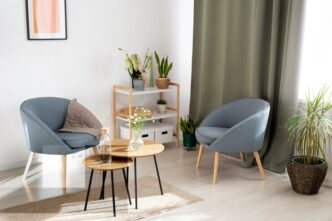For many years, the idea of a smart home has been all about voice commands, phone apps, and gadgets you can see. We talk to devices to change the temperature, tap on screens to dim the lights, and set timers for our machines. This way of doing things has certainly made life easier, but it is still a reactive experience. It always needs a person to give an order. What if the home itself could notice, learn, and act on its own? What if it could create a living space that responds not to commands, but to our simple presence and movement? This is not an idea from a future movie; it is the real-world change happening today through new smart home innovation. The next big step in this journey is not found in the devices on our walls, but under our feet, in the very floors we walk on.
This article looks at the amazing world of smart floors and carpet sensing technology. This is a new kind of smart home solution that is quietly bringing in a new time of home convenience, energy savings, and smooth environmental control. Leading this change are companies like TiveTech. Their work in adaptive sensing shows how an intelligent carpet can become the brain of a truly smart home.
Identifying the Limitations of Current Smart Home Systems
Most smart homes today work on a system of direct orders. A person must consciously decide to change their environment and then give a command, by voice, an app, or a switch. This creates a few problems:
- Mental Work: People have to constantly manage their surroundings, making small choices about lights, heat, and other systems all day long.
- Wastefulness: Rooms are often heated, cooled, or lit for hours when no one is in them. Lights stay on in empty halls, and air conditioning cools spaces with no people, leading to a lot of wasted energy.
- Lack of Understanding: A normal smart thermostat might learn your schedule, but it cannot tell if you are just walking through a room or sitting down to read. It does not understand the details of what you are actually doing.
The next step in the growth of a smart lifestyle is to move from a home you talk to, to a home that thinks ahead. This needs a home that can “see” without cameras and “listen” without microphones, a home that senses presence and movement quietly and without being annoying.
Smart Floors and Carpets: The Foundational Layer of Intelligent Living Spaces
The answer to these problems is a technology that is as common as it is ignored: the floor. Smart floor and intelligent carpet systems are a new way of thinking about how a home interacts with the people living in it. By placing advanced sensors into flooring materials, these systems can detect if someone is there, find where they are moving, tell the difference between a person and a pet, and even understand how active someone is, all without a single spoken word.
This floor sensing technology works in a way similar to the touchscreens on our phones, but made much bigger. It creates a hidden, responsive area across the whole floor of a room. Unlike micro cameras often used in motion sensors, smart carpets and floors prioritize privacy while still detecting movement accurately. When a person steps onto this area, their presence is noticed, starting a series of automatic actions made to improve smart living.
How Does This Adaptive Sensing Work?
The heart of this technology, which TiveTech focuses on, is adaptive sensing. It mixes advanced sensor technology with artificial intelligence to create a system that is both accurate and smart. The sensors do not just detect that “something” is there; they understand the information. They can tell the difference between a person walking across the room and a pet running by, or between someone standing still in the kitchen and someone walking around the living room. Importantly, all this data analysis occurs locally within the home, ensuring that personal information never leaves the system and privacy is fully protected.
This adaptive sensing platform learns the unique habits of a household. It understands the busy morning movement from the bedroom to the kitchen, the quiet of the afternoon when the home might be empty, and the calm evening movement between rooms. This constant, quiet learning lets the system make more and more correct and helpful changes to the home’s environment.
Key Advantages of Smart Floor and Carpet Sensing Technology
Putting a smart carpet or smart floor system into a home gives many benefits that directly fix the weak points of normal smart homes, greatly improving daily life.
- Great Energy Savings and Environmental Control
One of the biggest and fastest impacts of this technology is on a home’s energy use. Environmental control becomes active and exact.
- Specific Climate Management: Instead of heating or cooling a whole house based on one thermostat, the system can control the climate in specific zones. For example, it can send heat to the home office only when it senses someone has walked in and sat down, leaving other rooms at a temperature that saves energy. When the system notices that the last person has left the house, it can automatically lower the heat and turn off all lights that are not needed.
- Smart Lighting: Lights can turn on to light a path in front of a person as they walk through the house at night and turn off behind them after they leave. During the day, electric lights can turn on only in the exact spots where people are, saving power.
This active management stops the huge energy waste that comes from heating, cooling, and lighting empty spaces. This leads to lower bills and a much smaller impact on the planet.
- Seamless Home Automation and Advanced Safety Features
The main goal of a smart home solution is to make life easier and safer, and smart floors do this perfectly.
- Smooth Automation: Imagine walking into your kitchen in the morning, and the lights under your cabinets softly turn on to help you make coffee, while the big main light stays off to save energy. As you carry a basket of laundry, the hallway lights light up your path, and the basement light turns on just before you open the door. This is the best kind of home convenience, automation that feels natural and needs no effort from you.
- Safety for Everyone: For families with young children or older family members, the safety uses are very important. The system can detect if someone has fallen and has not moved for a while, automatically sending a message to family or calling for help. It can watch the movement patterns of seniors who live alone, giving peace of mind to their families without needing to use cameras.
Beyond general safety, this adaptive flooring technology offers significant benefits for people with disabilities. It can detect movement patterns, provide automatic lighting or climate adjustments, and alert caregivers if needed. By supporting independent living and making daily navigation easier, smart floors help create a more inclusive home environment for everyone.
- Achieving Effortless Comfort Through Silent, Adaptive Intelligence
Maybe the most important benefit is the pure comfort of a home that changes for the people in it. This is the achievement of a true smart lifestyle, where technology works quietly in the background.
The system’s ability to understand presence and activity means it can create a space that is perfectly matched to the flow of daily life. It gives comfort without being asked and offers control without needing a remote. This quiet, adaptive way of working is what separates a group of smart gadgets from a home that is truly connected and intelligent. It removes the hassle of technology, letting people just live their lives, supported by a space that understands and answers their needs.
TiveTech: Leading Smart Home Innovation with Adaptive Sensing
While the idea of smart floors is strong, making it work needs complex technology and a clear plan. This is where companies like TiveTech are making a big difference. Started in 2019, TiveTech has become a specialist in creating adaptive sensing platforms that use advanced sensors and AI to solve real-life problems.
The company’s main goal of building “the future through adaptive innovation” is shown perfectly in its way of handling the smart home. TiveTech is not just making another device; it is creating a basic layer of intelligence for the modern home. Their special smart home solution is a great example of this idea, focusing on “Comfort and Control, Silently.”
TiveTech’s system uses its own smart carpet technology to sense foot movement very accurately. This technology turns the simple act of walking into information that manages the living space. By understanding small details of presence and activity, the system can automatically change lighting, heating, and cooling, working quietly to stop energy waste while making life more comfortable.
Expanding the Future of Adaptive Sensing Beyond Residential Spaces
The uses for smart floor technology go far beyond just one home. The ideas of adaptive sensing made by innovators like TiveTech have huge potential in many areas:
- Office Buildings: Saving energy in big offices by heating, cooling, and lighting only the areas and meeting rooms that are being used, leading to huge cost savings.
- Hospitals and Care Homes: Watching patient movement to stop falls and make sure help comes quickly, while also saving energy in rooms that are not used often.
- Stores: Studying how customers move through a store to make better layouts and product displays, creating a nicer shopping experience.
Also, TiveTech’s bigger plans, which include moving into power systems and renewable energy, point to a future where the smart sensing of a building is connected to its power creation and distribution. A smart home that can sense can work perfectly with solar panels and smart energy grids, selling extra power when it is valuable or using power when it is most efficient, creating a home that is truly sustainable and manages itself.
Shaping the Future of Smart and Sustainable Living
The growth of the smart home is moving from things you notice to things you don’t, from needing interaction to being intuitive. The most powerful technological changes are often the ones that disappear into the background, becoming a hidden but essential part of our everyday lives. Smart floor and carpet sensing technology, as supported by forward-thinking companies like TiveTech, shows this kind of change exactly.
It offers a future where our homes are not just connected but are aware and helpful partners in our daily routines. They provide amazing home convenience, advanced environmental control, and major energy savings, all while working with a quiet smartness that respects people. This is more than a smart home solution; it is the base for a safer, more efficient, and truly adaptable smart living space. As we keep looking for ways to blend technology with daily life, the answer, it appears, has been right under our feet the whole time.
To learn more about how adaptive sensing can change your living or working space, visit TiveTech and discover the future of smart home innovation.














